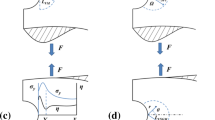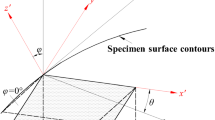Abstract
The paper presents an energetic approach useful to predict of the static and fatigue behavior of components weakened by sharp re-entrant corners. Despite the fact that stresses and strain energy density tend toward infinity at the point of singularity, the energy in a small volume of material surrounding the notch tip has obviously a finite value and such a value is thought of as the entity that controls the failure. The energy, averaged in a volume of radius R (which depends on the material properties), is a precise function of the Notch Stress Intensity Factors and is given in closed form for plane stress and plane strain conditions, the material being thought of as isotropic and linear elastic. The method is validated taking into account experimental data already reported in the literature, concerning both static tests carried out on polymethyl metacrylate (PMMA)and Duraluminium specimens and fatigue tests on welded joints and notched components in structural steels. As a matter of fact, the method proposed here is the re-formulation, on one hand, of some recent area/volume criteria (in which averaged values of the maximum principal stress are used to predict component fatigue limits) and, on the other, of N-SIF-based criteria, where the Notch Stress Intensity Factors are thought of as the parameters that control static and fatigue failures.
Similar content being viewed by others
References
Atzori, B. (1985). Fracture mechanics or notch effect for fatigue design. Proceedings XIII National Congress of the Italian Society for Strain Analysis(Edited by AIAS), Bergamo, Italy. (in Italian).
Atzori, B., Lazzarin, P., and Tovo, R. (1999a). From the local stress approach to fracture mechanics: a comprehensive evaluation of the fatigue strength of welded joints, Fatigue & Fracture of Engineering Materials and Structures22, 369–382.
Atzori, B., Lazzarin, P. and Tovo, R. (1999b). Stress field parameters to predict the fatigue strength of notched components, Journal of Strain Analysis. 34, 437–453.
Beltrami, E. (1885). Sulle condizioni di resistenza dei corpi elastici, Rend. R. Ist. Lombardo di Scienze, Lettere e Arti, 18, 704 (in Italian).
Boukharouba, T., Tamine, T., Nui, L., Chehimi, C. and Pluvinage, G. (1995). The use of notch stress intensity factor as a fatigue crack initiation parameter. Engineering Fracture Mechanics52, 503–512.
Bentachfine, S., Pluvinage, G., Gilgert, J., Azari, Z. and Bouami, D. (1999). Notch effect in low cycle fatigue. International Journal of Fatigue21, 421–430.
Bueckner, H.F. (1970), A Novel Principle for the Computation of Stress Intensity Factors. (Author spell out please) Z. Angew Meth Mech. 50, 529–546.
Carpinteri, A. (1987). Stress singularity and generalised fracture toughness at the vertex of re-entrant corners. Engineering Fracture Mechanics26, 143–155.
Carpinteri, A. and Pugno, N. (2000). Structures with re-entrant corners. Procs. XV National Conference IGF, Bari (Italy), 391–398.
Dunn, M.L., Suwito, W and Cunningham, S.J. (1997a). Fracture initiation at sharp notches: correlation using critical stress intensities. International Journal of Solids and Structures34, 3873–3883.
Dunn, M.L., Suwito W., Cunningham, S.J. and May, C.W. (1997b). Fracture initiation at sharp notches under mode I, mode II, and mild mixed mode loading. International Journal of Fracture84, 367–381.
El Haddad, M.H., Topper, T.H. and Smith, K.N. (1979). Prediction of non-propagating cracks. Engineering Fracture Mechanics11, 573–584.
Fett, T. (1996) Failure of brittle materials near stress singularities. Engineering Fracture Mechanics53, 511–518.
Froustey, C., Lasserre, S. and Dubar, L. (1992) Validité des critères de fatigue multiaxialee à l'endurance en flexion-torsion. Procs. Mat-Tech’ 92. IITT-International, France, 79–85.
Glinka, G. (1985). Energy density approach to calculation of inelastic strain-stress near notches and cracks. Engineering Fracture Mechanics22, 485–508.
Gradin, P.A. (1982). A fracture criterion for edge-bonded bi-material bodies. Journal of Composite Materials16, 448–456.
Gross, R. and Mendelson, A. (1972). Plane Elastostatic Analysis of V-Notched Plates. International Journal of Fracture Mechanics8, 267–227.
Gurney, T. R. (1991). The fatigue strength of transverse fillet welded joints. Abington Publishing, Abington, Cambridge.
Kihara, S. and Yoshii, A. (1991). A strength evaluation method of a sharply notched structure by a new parameter, ‘The equivalent stress intensity Factor'. JSME International Journal34, 70–75.
Kihl, D. P. and Sarkani, S. (1997). Thickness effects on the fatigue strength of welded steel cruciforms. International Journal of Fatigue19, 311–s316.
Knels, Z. (1991). A criterion of V-notch stability. International Journal of Fracture48, R79–R83.
Lazzarin, P. and Tovo, R. (1996). A unified approach to the evaluation of linear elastic stress fields in the neighborhood of cracks and notches. International Journal of Fracture78, 3–19.
Lazzarin, P., Tovo, R. and Meneghetti, G. (1997). Fatigue crack initiation and propagation phases near notches in metals with low notch sensitivity. International Journal of Fatigue19, 647–665.
Lazzarin, P. and Tovo, R. (1998). A notch intensity factor approach to the stress analysis of welds. Fatigue & Fracture of Engineering Materials & Structures21, 1089–1103.
Lazzarin, P., Zambardi, R. and Livieri, P. (2001). Plastic Notch Stress Intensity Factors for Large V-Shaped Notches under Mixed Load Conditions. International Journal of Fracture107, 361–377.
Maddox, S. J. (1987). The Effect of Plate Thickness on the Fatigue Strength of Fillet Welded Joints. Abington Publishing, Abington, Cambridge.
Moftakhar, A., Buczynski, A. and Glinka, G. (1995). Calculation of elasto-plastic strains and stresses in notches under multiaxial loading. International Journal of Fracture70, 357–373
Molsky, K. And Glinka, G. (1981). A method of elastic-plastic stress and strain calculation at a notch root. Material Science and Engineering50, 93–100.
Morel, F., Palin-Luc, T. and Froustey, C. (2001) Comparative study and link between mesoscopic and energetic approaches in high cycle multiaxial fatigue. International Journal of Fatigue23, 317–327.
Neuber H (1958). Theory of Notch Stresses. Springer-Verlag, Berlin.
Nui L.S., Chehimi, C. and Pluvinage G. (1994). Stress field near a large blunted tip V-Notch and application of the concept of the critical notch stress intensity factor (NSIF) to the fracture toughness of very brittle materials. Engineering Fracture Mechanics49, 325–335.
Park, J. and Nelson, D. (2000). Evaluation of an energy-based approach and a critical plane approach for predicting constant amplitude multiaxial fatigue life. International Journal of Fatigue22, 23–39.
Pluvinage, G. (1997a). Rupture and fatigue initiated from notches. Application of the notch intensity factor. Revue Francaise de Mecanique1997-1, 53–61 (in French).
Pluvinage, G. (1997b). Notch Effect in High Cycle Fatigue. Procs. ICF9, Sydney.
Radaj, D. (1990). Design and Analysis of Fatigue Resistant Welded Structures, Abington Publishing, Abington, Cambridge.
Seweryn, A. (1994). Brittle fracture criterion for structures with sharp notches, Engineering Fracture Mechanics47, 673–681.
Seweryn, A. and Mróz, Z. (1995). A non-local stress failure condition for structural elements under multiaxial loading. Engineering Fracture Mechanics51, 955–973.
Seweryn, A., Poskrobko, S. and Mróz, Z. (1997). Brittle fracture in plane elements with sharp notches under mixed-mode loading, Journal of Engineering Mechanics123, 535–543.
Taylor, D. (1999). Geometrical effects in fatigue: a unifying theoretical model, International Journal of Fatigue21, 413–420.
Taylor, D., Hughes, M., and Allen, D. (1996). Notch fatigue behavior in cast irons explained using a fracture mechanics approach. International Journal of Fatigue18, 439–445.
Tipton, S.M., and Nelson, D.V. (1997). Advances in multiaxial fatigue life prediction for components with stress concentrations. International Journal of Fatigue19, 503–515.
Verreman, Y. and Nie, B. (1996). Early development of fatigue cracking at manual fillet welds. Fatigue & Fracture of Engineering Materials & Structures19, 669–681.
Williams, M.L. (1952). Stress singularities resulting from various boundary conditions in angular corners on plates in tension, Journal of Applied Mechanics19, 526–528.
Yao, W. (1993). Stress field intensity approach for predicting fatigue life. International Journal of Fatigue15, 234–245.
Yao, W., Xia, K. And Gu, Y. (1995). On the fatigue notch factor, Kf. International Journal of Fatigue17, 245–251.
Author information
Authors and Affiliations
Rights and permissions
About this article
Cite this article
Lazzarin, P., Zambardi, R. A finite-volume-energy based approach to predict the static and fatigue behavior of components with sharp V-shaped notches. International Journal of Fracture 112, 275–298 (2001). https://doi.org/10.1023/A:1013595930617
Issue Date:
DOI: https://doi.org/10.1023/A:1013595930617




